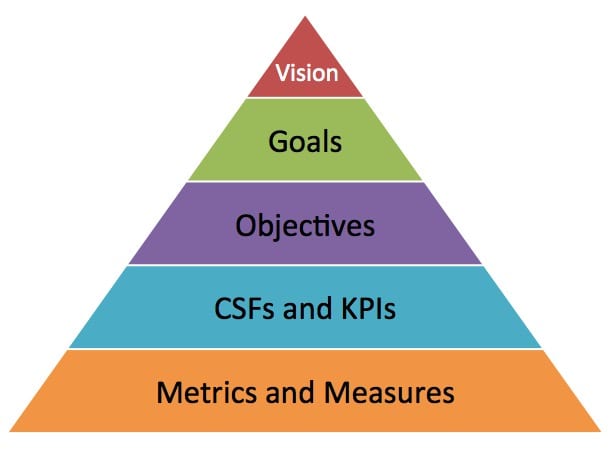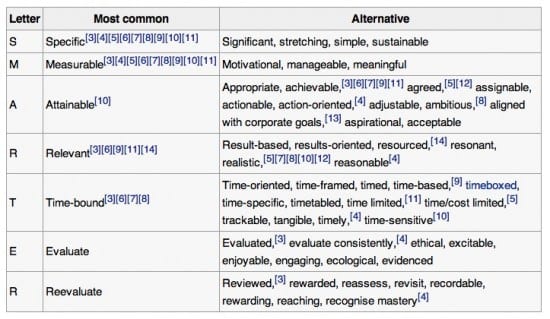How to ensure you track performance against target
KPIs, we all have them, sometimes we set them for ourselves, often they are set for us! The question is, are the KPIs you are reviewing supporting your efforts into making the boat go faster? Are they translated from business goals or just a bunch of metrics someone thought they may as well stick on a weekly powerpoint dashboard because Google Analytics spits out a sexy graph?
This post explores how you can ensure you are using the KPIs that are helping you track performance in line with your business goals? KPIs give an integral pulse on the business that helps keep you be aware of what's really going on and they allow you to exert control to pull the right levers to keep on track according to what actually matters. For me, the key when setting KPIs for marketing and digital marketing is to start with the business goals.
Download FREE Resource – Digital marketing plan template
Our popular marketing planning template built on the Smart Insights RACE planning system.
Access the Free digital marketing plan template
Be clear on the difference between goals, objectives and KPIs
I find when speaking to clients, that goals, objectives, and KPIs are used interchangeably by many. It's understandable but can lead to confusion within a business and when talking to providers. While there isn't a 'right or wrong' way to define these, it is definitely a good idea to have clarity on this. In this post, Dave Chaffey explains the difference between objectives vs goals. The approach he recommends is to have a clear top-down approach so goals support vision and more specific objectives add detail to goals.

Put another way, to show the difference between these units for target setting and evaluation,
Long-term Vision > Broad organisational goals > Specific SMART objectives > Performance driving KPIs
Note that this is just one way of defining it, you may decide to just use specific SMART goals. What's important is setting specific targets (goals or objectives) that you can evaluate performance against!
Ensure your targets are SMART (it doesn’t work otherwise)
If your targets (goals or objectives) aren’t SMART, they’re not clear for you to believe in and for others to follow. In fact, when they are not SMART, they can do more damage than good, causing multiple interpretations of what good looks like and possibly drive the wrong behaviour. This is key for all striving to achieve the goals, how will they know when they’ve smashed them. Ensuring your business goals and objectives are SMART ensures they are achievable and therefore celebrates success as well as highlight shortcomings, there’s nothing more demoralizing than a moving target and that’s what un-SMART business goals are! To be SMART they must be: Specific, Measurable, Actionable, Relevant and Time-related. Here's a summary of other ways to define SMART objectives:

There are more detailed resources on Smart Insights to help you evaluate your goals and objectives and run Digital Marketing Optimization.
Select your metrics for KPIs carefully
Remember that when selecting the metrics you are going to use for your KPIs, that using a score or calculation rather than a finite data point may be more useful. For example if you set a business objective to the leading voice in the local fish & chip market, and a goal to have your shop be mentioned in over 50% of all online fish and chip conversations in your local area by December 2015, then a simple ‘mentions’ metric pulled from a listening tool isn’t going to good enough to know if you are yet in the lions share of conversations. To get this ‘share of voice' you’re going to need to monitor all fish & chip conversations in the area as well to know what percentage your mentions make up of the total. So your KPI is made up of a score using two different data values.
Name them practically
Ensure they are always meaningful to your audience, even (god-forbid) engaging. Think carefully about the language you select to tell your story internally, and engage others (maybe your team, or your CEO) in sharing your value in a KPI. It’s OK to be a bit creative and less, well dull. What if we talked about new likes on Facebook as ‘audience waiting to be inspired’ or cart dropouts as ‘potential customers we failed’. This may seem a little over the top compared to the safe ‘click-through-rate’ or ‘reach’ numbers, but maybe its worth asking the question: Would more listen up and pay attention if the KPI actually described what was happening to the business? If you ran a card shop on the high street and you had 50% of customers walking out on you because paying was just too painful, would you talk to your staff about the ‘basket abandon rate’ that day, or talk to them about the 'customers we pissed off’. Yeah that’s right, the one that actually says what’s happening, evokes more urgency and action, and that actually helps frame ideas for solutions.
Stacey Barr offers some practical advice on naming KPIs.
Build process around checking in against KPIs
If you are not checking in your metrics, often, then they weren’t important in the first place. They are not the right ones. If you own a card shop, and your focus is on driving customer to your store from the high street around the corner, then footfall is a key indicator of success. So you monitor it, and think about it every day making small changes to what you write on your chalkboard each week to see what works in driving more people into your store. But without monitoring how many people come in every day, the owner cannot make an informed decision on if the message on the board is any good or not.
Ensure a plan of actions relates to the KPIs
Tracking your KPIs is one thing, but to ensure they are being used to achieve your business goals, they need to be related to, and generate action. Tracking and reporting on a KPI each week or month is only of use if the insights it brings helps shape action to keep on track with the goal. A simple way to building a process in your business around your KPIs is with a 90-day plan. This simple approach not only keeps KPIs actionable metrics, but drives a regular process of discussion and decision-making so they don’t get locked away in a draw and only discussion in new year’s planning round. Bring KPIs to life with regular reviews and actions will demonstrating your team are firmly aligned to the goals of the business… and not just see as reporting for digital marketing self-indulgence.
The most important aspect of KPIs are they are owned and useful. Otherwise, they will just be regarded as reporting for reporting’s sake. Used well they help keep the agenda clear and simple, driving teams to focus and allowing the celebration of success. Most of all they help your digital team be relevant to the business.
If you're looking for an alternative view, a good place to start is Avinash Kaushik’s explanation of goals, KPIs and metrics in the context of web analytics.
* Featured image courtesy of www.translatingyourworld.com










